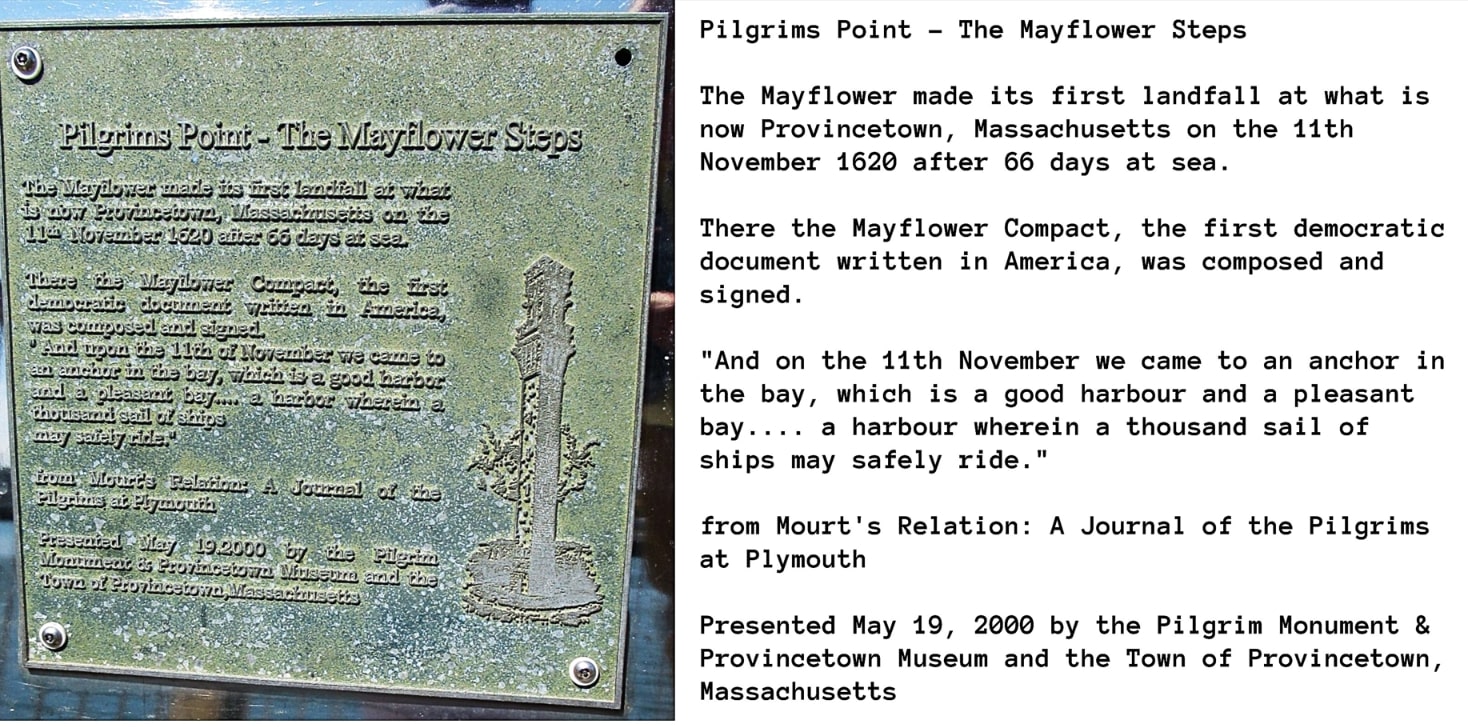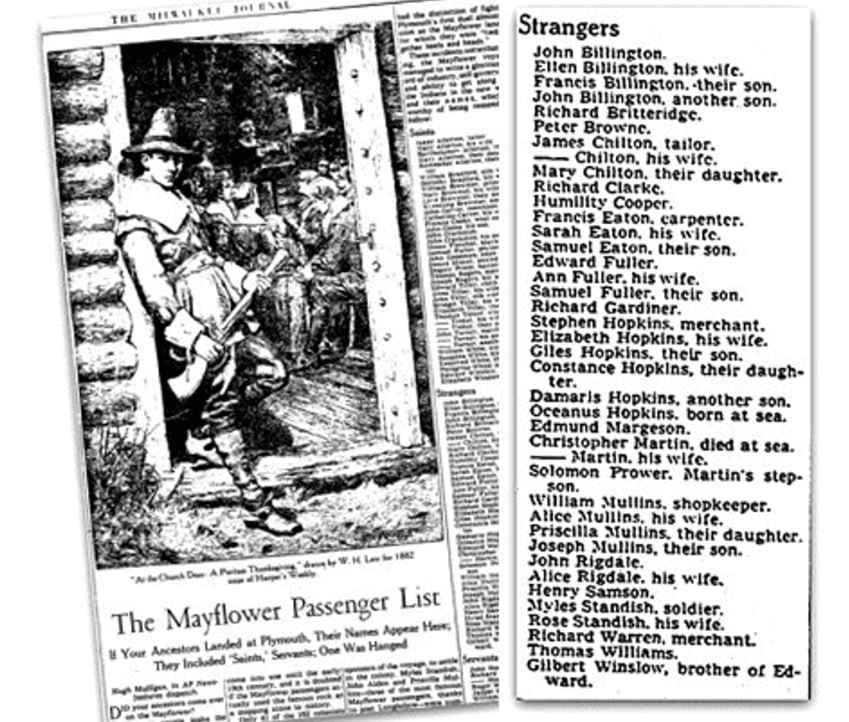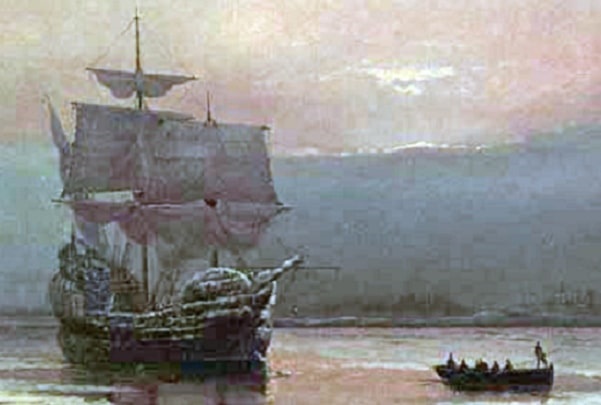Introduction: In this article, Melissa Davenport Berry continues her series on Mayflower descendants, focusing on the family lines of William Brewster and John Billington. Melissa is a genealogist who has a website, americana-archives.com, and a Facebook group, New England Family Genealogy and History.
Today I continue with my series on “Mayflower Descendants: Who’s Who,” again focusing on Elizabeth Anne (Annis) Coughlin, a direct descendant of Mayflower passengers Elder William Brewster, the spiritual leader of Plymouth Colony, and the not-so-pious but very colorful John Billington.
Of the 102 passengers who came to the New World on the Mayflower, about half were Separatists – Puritans who wanted to break from the Church of England and find religious freedom on the other side of the Atlantic. The other half were tradespeople hired by the Mayflower’s investors to help the new colony succeed. The religious contingent called themselves “Saints” (William Brewster was one) and called the tradespeople “Strangers” (this group included John Billington).

To recap: Recently I have been working with two separate Massachusetts families on their applications for membership into the General Society of Mayflower Descendants. Both descend from William Brewster through his daughter Patience, who married Governor Thomas Prence.

Elizabeth Anne (Annis) Coughlin
My first client, Elizabeth Anne (Annis) Coughlin, descends from William Brewster through her paternal side via the marriage of her second gr. great grandmother Sarah Jane Worthylake to Arthur H. Annis, son of Elisha Gardner and Jane Ewart (Bryden) Annis. (See Part 1 for the full lineage.)
Sarah Jane (Worthylake) Annis (1860-1940) was born in Nova Scotia to George Edward and Mary E. (Tibbits) Worthylake, and is a direct descendant of George Worthylake, the first lighthouse keeper of Boston whose story is worthy of the annals.
The Billington Clan
However, before we begin with the keeper of light, I must include another ancestor in Elizabeth Anne (Annis) Coughlin’s tree who sailed on the Mayflower – and that is John Billington.
Here is Elizabeth’s lineage match to John Billington.
Elizabeth descends from Billington’s son Francis, who along with his brother John Jr. created chaos in the new colony. In fact, Francis nearly blew up the Mayflower before it even landed on shore.
In fact, the Billington brothers have been dubbed “America’s First Juvenile Delinquents.”
This article reports:
The Mayflower was still riding at anchor off the tip of Cape Cod, when Francis was accused of nearly blowing the sturdy three-master sky high.
His prank is recorded in full detail in “Mourt’s Relation,” a journal written by William Bradford and Edward Winslow to attract new settlers to the colony.
“The fifth day (of December, 1620),” so the journal relates, “we through God’s mercy escaped a great danger by the foolishness of a boy, one Francis of Billington’s sonnes, who in his father’s absence had got gun powder and shot off a piece or two and made squibs (pellets), and there being a fowling piece charged in his father’s cabbin shot her off in the cabbin.
“There being a little barrell of powder halfe full scattered in and about the cabbin, the fire being within foure foote of the bed betweene deckes and many flints and iron things about and so many people about the fire. And yet by God’s mercy no harme was done.”
The brothers’ parents had their own share of drama: Daddy Billington was the first among the adults to commit murder. He was hanged 10 years after the Mayflower landed; and Mama Billington was sentenced to sit in the stock and be whipped for slander against John Doane.
Below are photos of Elizabeth’s grandfather and father, the 12th and 13th generations of Mayflower passengers William Brewster, Patience Brewster, John Billington, and Francis Billington.
There is no historian who serves up the skinny on the Plymouth Pilgrims better than Edward Rowe Snow, historian, Flying Santa, and himself a direct descendant of Mayflower passengers.
Here is Snow’s intel on John Billington and his family, published in the Patriot Ledger from his column “Sea and Shore Gleanings.”
This article reports:
John Billington with his wife, Eleanor, and their two boys, John and Francis, came across the ocean in the Mayflower in 1620. Like some of the other Pilgrims, they were not members of the church, but were willing to cast their lot with those visitors to the New World.
Eleanor was a quiet, pious woman, kind, generous, and faultless, until made insane by “the deep damnation” of her husband’s “taking off,” according to family tradition.
The Billingtons possessed more worldly goods than most of the Pilgrims, and built one of the first dwelling houses in the colony.
The father and sons were strong and healthy, fond of the woods. They enjoyed hunting and fishing, which helped support the sufferers during the terrible scourge of the first winter.
The Billington family, with Elder Brewster and two or three others who escaped the terrible pestilence, devoted all their energies to waiting upon their sick and suffering companions. Governor Bradford and Thomas Morton both wrote that they were much loved, a family of industry and enterprise.
The elder Billington was selected by Miles Standish as his chief lieutenant and man-at-arms, and he joined in all military exploits. He signed the Mayflower contract, stood by the others faithfully in all encounters with the natives, and bore all the burdens of toil and difficulty.
However, all the years of kindness and companionship counted for nothing when trials and misfortune came upon him.
Billington had evidently incurred Governor Bradford’s bitter enmity in some way, and in spite of his earlier praise, Bradford eventually turned against him.
The whole story of John Billington’s accusation, trial, and execution is clouded in mystery and contradiction. Bradford gave it 11 lines in his journal which he wrote 20 years after the occurrence.
To be continued…
Explore over 330 years of newspapers and historical records in GenealogyBank. Discover your family story! Start a 7-Day Free Trial
Note on the header image: “Mayflower in Plymouth Harbor,” by William Halsall, 1882. Credit: Wikimedia Commons.
Related Articles:
